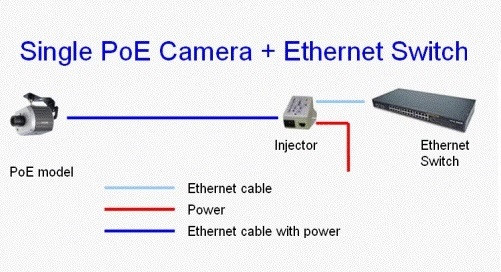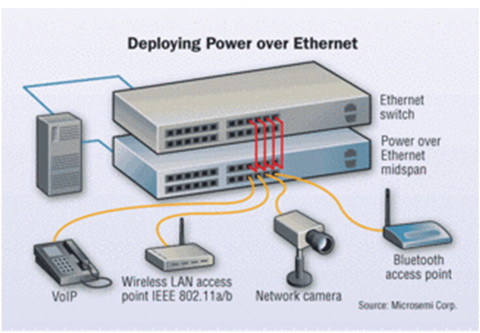What are the hottest technologies in today’s networking industry? Everyone may have his/her own ideas, but WiFi (wireless networking) and VoIP (Voice over Internet Protocol) are undoubtedly near the top. Recently, several enterprises announced plans for WiFi coverage and a global rollout of IP phones. WiFi and VoIP, in addition to being current industry buzzwords, also share another common attribute—they both require Ethernet and power to function. In 2003, the Institute of Electrical and Electronics Engineers (IEEE) released IEEE 802.3af, also known as the Power over Ethernet (PoE) standard, which provides a universal way to provide power and Ethernet-based data to a remote powered device over standard Ethernet cabling such as Cat5e or Cat6. Fiber optic cable like LC to FC patch cord is not suitable for PoE technology. This article will guide you through standard and method within PoE that will help you success in this field.
What You Need to Know About PoE
PoE is a standard allowing users to power certain network or IP devices over that same data cable that connects it to a network. Specifying Power over Ethernet brings many advantages to an installation. The following picture presents a simple diagram of PoE technology.

- Flexibility—without being tethered to an electrical outlet, devices such as IP cameras and wireless access points can be located wherever they are needed most, and repositioned easily if required.
- Safety—PoE delivery is intelligent, and designed to protect network equipment from overload, underpowering, or incorrect installation.
- Reliability—POE power comes from a central and universally compatible source, rather than a collection of distributed wall adapters. It can be backed-up by an uninterruptible power supply, or controlled to easily disable or reset devices.
- Scalability—having power available on the network means that installation and distribution of network connections is simple and effective.
- Time and Cost Savings—by reducing the time and expense of having electrical power cabling installed. Network cables do not require a qualified electrician to fit them, and can be located anywhere.
Deploying Power over Ethernet
The IEEE standard recognizes two methods for deploying PoE in your network. The first requires that Ethernet switches inject power and data at the same time. This approach is suitable for new installations, in which a new switch must be purchased anyway; and it requires a much larger power supply and will likely be more expensive than a standard Ethernet switch. These devices are referred to in the 802.3af standard as "endspan" devices, since the power is injected at the end of the structured cabling where it terminates on the Ethernet switch.
The second method (see in following picture) involves using a dedicated power-injecting device in between the Ethernet switch and the remote powered device. These power-injecting devices are known in the standard as "midspan" devices, and work well for both new and existing installations with non-PoE-enabled Ethernet switches. Midspans offer a more-flexible option than PoE-capable switches, and are deployed between the switch and PDs without changing the existing infrastructure. The second method using midspan devices is treated as the most cost-effective way to deploy PoE in cabling infrastructure.

How to Ensure PoE Success
When deployed correctly, PoE is safe, reliable, and cost-effective. But PoE itself is such a new networking technology, it is essential to consider factors to ensure successful PoE deployments:
1.Provide sufficient power to the remote powered device.
This may sound simple, but in practice, it is difficult. The IEEE 802.3af standard identifies four possible power classifications. At maximum, the powered remote device can draw up to 12.95 watts of power. Factoring loss through the length of the cable, this means that, at maximum, the power-sourcing equipment must have the ability to provide 15.4 watts of power to each port. In a 24-port Ethernet switch or midspan device, this means that approximately 370 watts of power must be available to supply the necessary power to each port.
With this in mind, you must pay close attention to the size of the power supply used in each device. Midspan devices should have in excess of 370 watts available and Ethernet switches should have significantly more, depending on how much power their switching functions require. A rule of thumb is to check the power-supply size used on a non-PoE-enabled switch and add 15.4 watts per port to determine if the power supply is large enough. Connect the critical power-sourcing devices to an uninterruptible power supply, and use devices with dual redundant power supplies to ensure that your critical devices never lose power.
2.Deploy only IEEE 802.3af-compliant devices.
Before release of 802.3af, many companies chose to develop products to various proprietary standards in order to provide PoE cabling. Many of these devices are still being sold, even though the standard is now released. Be sure to verify that both the sourcing device and the powered remote device are compatible with each other. If both devices list IEEE 802.3af in their specifications, you are covered. But if any of the devices you are using do not explicitly state compliance to IEEE 802.3af, be cautious. Carefully read the technical documentation and contact the technical-support number to determine compatibility. Failure to do so will leave you frustrated and will cost you time and money.
3.Pay attention to cabling-performance specifications.
As noted before, Category 5e or 6 are the Category rating for Power over Ethernet deployment. And if you deploy Power over Ethernet with a midspan device, how does that affect your performance? Pay close attention to the manufacturer's specifications. Look for Category 5e and 6 compliance. Midspans should be treated just like another patch panel in your channel; if they are of an unkown Category or one lower than the rest of your cabling, you may be significantly disregarding the performance of your infrastructure. Also, remember that per TIA standards, only four connectors can exist between the switch or hub and the network interface card (NIC). A midspan device should be counted and treated as one of these connection points.
4.Use the most cost-effective PoE method for your network.
The business motivation behind deploying IP-based technologies like WiFi and VoIP is to decrease networking costs. A significant benefit of PoE is that it runs on your existing infrastructure. If you have recently purchased or upgraded your Ethernet switches, but they are not compliant to the IEEE 802.3af standard, before you run out and buy all new Ethernet switches (which you probably won't do), and before you abandon or delay your project (which you don't want to do), consider using midspan devices to inject power. These devices are economical to purchase and install relative to Ethernet switches, and they let you insert standards-compliant PoE using your existing infrastructure, including the existing Ethernet switch.
Conclusion
Properly deployed PoE technology in your network will lead to a safe, reliable, and economical solution for delivering consistent and dependable power to such common networking devices as VoIP phones and WiFi access points. Regardless of where the power is injected, the limitation of link distance is 100 meters from the switch or hub to the NIC. FS.COM provides a full range of fiber optic cables and copper cables, such as LC to SC fiber cable, SC to LC patch cable, cat5e, cat6, cat6A and cat7, etc. Reliable optic devices are designed to improve your network performance.
评论
发表评论